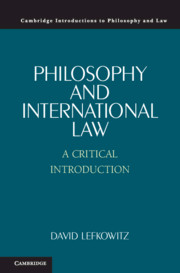Book contents
- Philosophy and International Law
- Cambridge Introductions to Philosophy and Law
- Philosophy and International Law
- Copyright page
- Dedication
- Contents
- 1 Introduction
- 2 John Austin: Enforcement and International Law
- 3 H.L.A. Hart: Social Rules, Officials, and International Law
- 4 Ronald Dworkin: Interpretivism and International Law
- 5 An International Rule of Law?
- 6 The Legitimacy of International Law
- 7 International Human Rights Law: Concepts and Grounds of Human Rights
- 8 The Law of War and Its Relationship to the Morality of War
- 9 International Criminal Law: Crimes Against Humanity and Universal Jurisdiction
- 10 International Law and Secession
- 11 International Trade Law: Free Trade, Fair Trade, and Trade in Stolen Goods
- Bibliography
- Index
10 - International Law and Secession
Published online by Cambridge University Press: 10 October 2020
- Philosophy and International Law
- Cambridge Introductions to Philosophy and Law
- Philosophy and International Law
- Copyright page
- Dedication
- Contents
- 1 Introduction
- 2 John Austin: Enforcement and International Law
- 3 H.L.A. Hart: Social Rules, Officials, and International Law
- 4 Ronald Dworkin: Interpretivism and International Law
- 5 An International Rule of Law?
- 6 The Legitimacy of International Law
- 7 International Human Rights Law: Concepts and Grounds of Human Rights
- 8 The Law of War and Its Relationship to the Morality of War
- 9 International Criminal Law: Crimes Against Humanity and Universal Jurisdiction
- 10 International Law and Secession
- 11 International Trade Law: Free Trade, Fair Trade, and Trade in Stolen Goods
- Bibliography
- Index
Summary
Following some preliminary remarks on the concept of secession and its status in international law, this chapter examines competing answers to two questions that any theory of state secession must address.First, what sort of actor enjoys a prima facie moral right to secede, and in virtue of what features or considerations does that actor do so?Second, on what particular territory is an actor with a right to secede permitted to exercise that right?It then evaluates arguments for and against several international legal norms that might be adopted to regulate unilateral secession, drawing on both moral theories of secession and empirically informed conjectures regarding the incentives those norms might create for various international and domestic actors.
Keywords
- Type
- Chapter
- Information
- Philosophy and International LawA Critical Introduction, pp. 202 - 229Publisher: Cambridge University PressPrint publication year: 2020



